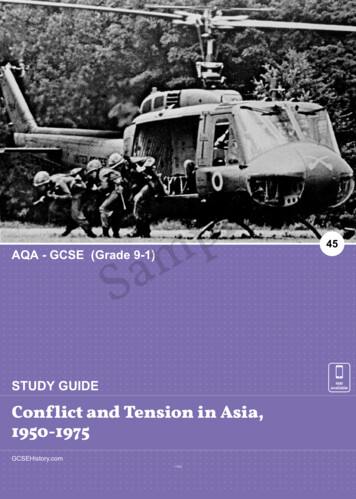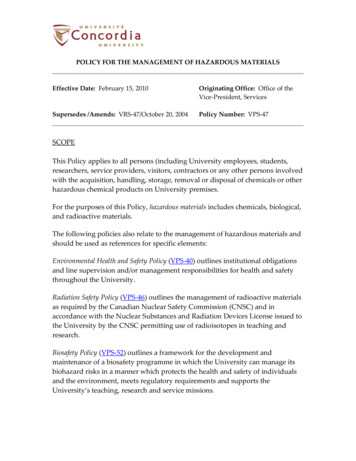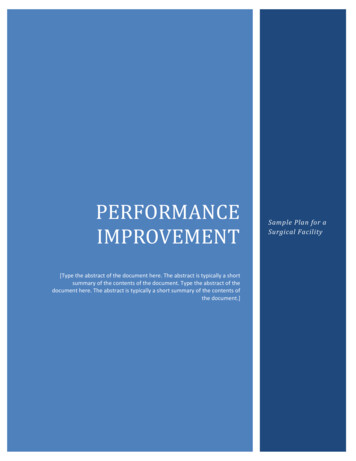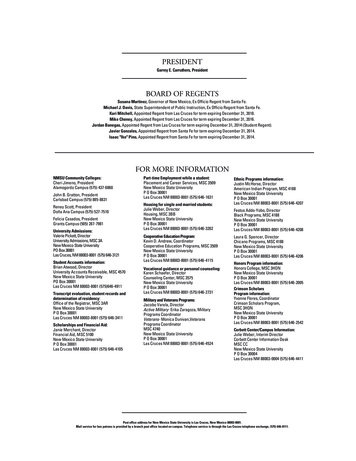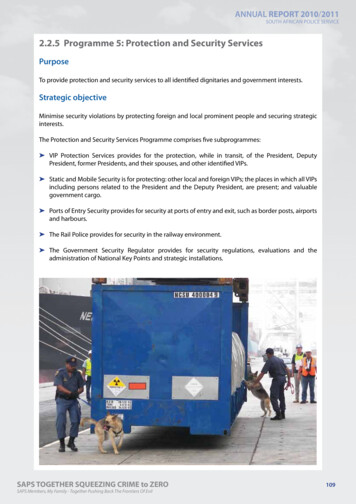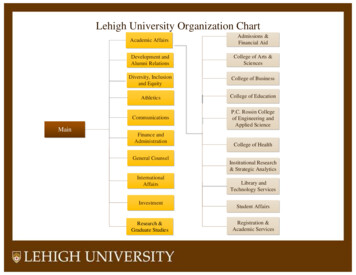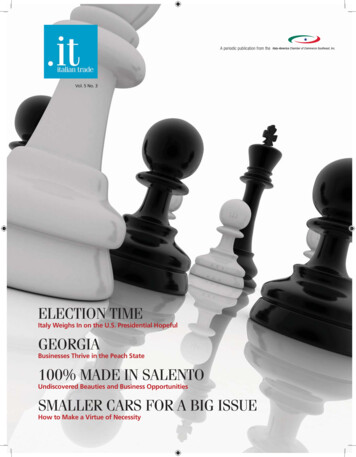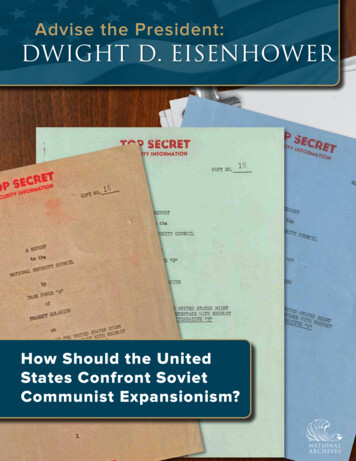
Transcription
Advise the President:DWIGHT D. EISENHOWERHow Should the UnitedStates Confront SovietCommunist Expansionism?
DWIGHT D. EISENHOWERAdvise the President:DWIGHT D. EISENHOWERPlace: The Oval Office, the White HouseTime: May 1953How Should theUnited StatesConfront SovietCommunistExpansionism?The President is in the early months of his first termand he recognizes Soviet military aggression and thesubsequent spread of Communism as the greatest threatto the security of the nation. However, the current costsof fighting Communism are skyrocketing, presenting asignificant threat to the nation’s economic well-being.President Eisenhower is concerned that the costs are notsustainable over the long term but he believes that thespread of Communism must be stopped.On May 8, 1953, President Dwight D. Eisenhower hascalled a meeting in the Solarium of the White Housewith Secretary of State John Foster Dulles and TreasurySecretary George M. Humphrey. The President believesthat the best way to craft a national policy in a democracyis to bring people together to assess the options. Inthis meeting the President makes a proposal basedon his personal decision-making process—one that isgrounded in exhaustive fact gathering, an open airing ofthe full range of viewpoints, and his faith in the clarifyingqualities of energetic debate. Why not, he suggests, bringtogether teams of “bright young fellows,” charged withthe mission to fully vet all viable policy alternatives? Heenvisions a culminating presentation in which each teamwill vigorously advocate for a particular option before theNational Security Council.The teams have done their work, and it is time to presenttheir findings. You are an adviser to the President andmust help him make the ultimate decision.STEP INTO THE OVAL OFFICE.THE PRESIDENT IS EXPECTING YOU.2Advise the President
DWIGHT D. EISENHOWERBackgroundAmericans are threatened by the expansion of Communism, and many believe it endangers our nation’sexistence. This chart helps explain some of the differences between the United States and the Soviet Union.In the United States . . .In the Soviet Union . . .What are themost importantvalues?The system of government is based onindividual political power and the ideals offreedom and equality.The system of government is based onthe idea of “common ownership.”Who owns property?Individual citizens own personal property andpossessions.All resources belong to the community.There is no private property.Who makes decisions?Citizens elect representatives who make rulesand govern with the consent of the people.A self-selected individual or groupof people holds power and makesdecisions for everyone else.Who controls wealth?Prices and wages are determined by businesscompetition in a free market. Individuals orgroups form their own businesses, which canlead to the development of wealth.The government has complete controlover the production and distribution ofgoods.Americans are worried that the spread of Communism threatens their freedoms,their individuality, and their way of living.Prior to World War II, Joseph Stalinaggressively transformed thecommunist Soviet Union into atotalitarian state. A ruthless dictator,Stalin orchestrated the death ofmillions of Soviet citizens. Heforced the collectivization of Sovietfarms so that individuals could notproduce or sell their own crops orlivestock. People who resisted thisor any other policy implementedby Stalin were sent to labor campsor were killed. During World War II,the United States decided that NaziGermany posed so great a threatto the security of the free world,that it allied with the Soviet Unionin order to defeat the Nazis. Butafter World War II, Stalin continuedhis aggressive tactics to spreadCommunism around a shatteredPresident Eisenhower with Secretary of State John Foster Dulles. Their May 8, 1953,world.meeting on national security in the White House solarium led to the creation of ProjectSolarium.Stalin’s death in March 1953 created a leadership vacuum and increased tensions between the United Statesand the Soviet Union. The United States sensed heightened danger, driven by the threat of ever-increasingSoviet nuclear capabilities. President Eisenhower now recognizes the need to craft a new national securitypolicy. While he hopes to resolve the situation peacefully, he feels that he needs all the options on the table.Advise the President3
DWIGHT D. EISENHOWERA Chance For PeaceIn April 1953, President Eisenhower argued that continuing tension between the UnitedStates and the Soviet Union blights the lives of millions of people around the globe. Hespoke eloquently on the human consequences of continuing on this path.“This has been the way of life forced by eight years of fear and force. What can theworld, or any nation in it, hope for if no turning is found on this dread road? The worstto be feared and the best to be expected can be simply stated. The worst is atomicwar. The best would be this: a life of perpetual fear and tension; a burden of armsdraining the wealth and the labor of all peoples; a wasting of strength that defies theAmerican system or the Soviet system or any system to achieve true abundance andhappiness for the peoples of this earth.Every gun that is made, every warship launched, every rocket fired signifies, in thefinal sense, a theft from those who hunger and are not fed, those who are cold andare not clothed. This world in arms is not spending money alone. It is spending thesweat of its laborers, the genius of its scientists, the hopes of its children. The costof one modern heavy bomber is this: a modern brick school in more than 30 cities. Itis two electric power plants, each serving a town of 60,000 population. It is two fine,fully equipped hospitals. It is some 50 miles of concrete highway. We pay for a singlefighter plane with a half million bushels of wheat. We pay for a single destroyer withnew homes that could have housed more than 8,000 people.This, I repeat, is the best way of life to be found on the road the world hasbeen taking. This is not a way of life at all, in any true sense. Under the cloud ofthreatening war, it is humanity hanging from a cross of iron. These plain and crueltruths define the peril and point the hope that comes with this spring of 1953. This isone of those times in the affairs of nations when the gravest choices must be made,if there is to be a turning toward a just and lasting peace. It is a moment that callsupon the governments of the world to speak their intentions with simplicity and withhonesty. It calls upon them to answer the question that stirs the hearts of all sanemen: is there no other way the world may live?”The President called for an end to the Cold War and a new era in U.S.–Soviet relations.But at the same time, he knew that the United States and the free world must defendthemselves from the ever-expanding reach of Communism. The question now was: Howwould that new policy be achieved?4Advise the President
DWIGHT D. EISENHOWERProject SolariumThe conversation in the Solarium led to thedevelopment of a very specific strategic planningprocess known as Project Solarium. PresidentEisenhower created three task forces (knownas A, B, and C). Each was charged with makingthe best possible arguments for one potentialcourse of action. The President has been verymuch involved in the development process,outlining the structure and processes for theexercise, articulating the policy options, andeven recommending the persons to serve on thethree task forces. The project is top secret, andduring the summer of 1953 participants are beingsequestered at the National War College at FortMcNair in Washington, DC.Task Forces A, B, and C are staffed by 21members who include subject-matter experts,diplomats, and military officers, working inisolation for approximately six weeks of intense12—14 hour days. The teams have been givenunrestricted access to the expertise andinformation of the United States Government.Through this comprehensive and deliberativeprocess, President Eisenhower believes thathe and his advisors will build a solid basis uponwhich to make the decisions that will lead to anew national security policy.Each task force approaches the problem froma different perspective. While all agree on thebasic assumption that Communism should notbe allowed to expand, each group will pursue adifferent option to preventing it. The Presidentand his team will listen to each presentation; thenthe President will make his own decision aboutfuture foreign policy.GLOSSARYCommunism: an economic system based on the idea of “common ownership”of all resources by all citizens. Individuals do not own private property.Democracy: a form of government based on the political power of individuals and the ideals offreedom and equality. Individual citizens are responsible for their own decisions and successes.Cold War: period of extreme political and military tension short of armed conflict between the UnitedStates and the Soviet Union.Soviet bloc: groups of countries dominated or controlled by the Soviet Union.Free world: the countries aligned with the United States and Western Europe.Brinksmanship: the idea that pushing the military to the brink of a war (without actually starting thewar) will convince another nation to accede to your demands.Containment: a policy to control the spread of Communism by physically limiting it to the countrieswhere it already exists.General war: term for future worldwide military conflict that would include the use of nuclear weapons.Advise the President5
DWIGHT D. EISENHOWER6Advise the President
DWIGHT D. EISENHOWERThe White HouseWashingtonTHE OPTIONSHow Should the United States Confront Soviet Communist Expansionism?Each option presents specific action steps that you could take, but each action alsoraises the possibility of serious consequences. There may be no clear answer. Beforeyou decide, take some time to review the details of each option and weigh thearguments and drawbacks for each.Option A: Contain CommunismWe should contain Communism within its current borders and allow the inherentweaknesses of the Communist system to cause it to decay over time from the insideout. Our focus should be on building up the strength of the free world while pressuringthe Soviets economically and diplomatically.Option B: Threaten Massive RetaliationWe should draw a “line in the sand” and tell the Soviet Union that any attempt toexpand Communism over that line will result in a massive and severe retaliationfrom the United States. Our focus should be on building up our own militarycapability to support that threat if the Soviet Union acts.Option C: Liberate the Soviet Bloc from CommunismWe should take aggressive and proactive steps to roll back Communism andfree all people from Communist systems. Our focus should be on using allavenues—including military action—to liberate the people of the Soviet blocfrom the oppression of Communism.Advise the President7
DWIGHT D. EISENHOWEROPTION A: Isolate Communism and Apply PressureThe United States must contain Soviet expansioninside its current boundaries and apply pressureon the Soviet Government until Communismcollapses. According to this option, Communismis an inherently flawed system that will fail, evenwithout aggressive action by the United States.The United States should focus on buildingup and maintaining the economic, diplomatic,political, and military strength of the free world,while pressuring the Soviet Union economicallyand diplomatically. Eventually, Soviet power willdeteriorate to a point that no longer constitutesa threat to the security of the United States andto world peace, and the political and economicsystems of the United States will prevail.In order to stop the spread of Communism, “there isone single factor which is essential [. . .]: that is thepolitical climate of the non-Communist world” (TaskForce A report to the National Security Council).It is vital for the United States to pursue strongerrelationships with our allies. Wherever possible, wemust seek to strengthen free nations around theworld with American investment and economic aid.Indeed, the United States should “continue to assistin building up the economic and military strengthand cohesion of the free world” (Task Force Areport to the National Security Council). Sovietexpansion is best checked through targeted effortsto strengthen Western Europe’s war-weakenedeconomic, political, military, and diplomatic systems.We can also contain the spread of Communism byapplying pressure on the Soviet Government. It is“possible to create in the minds of Soviet leaders animage of United States posture and policy which willdiscourage Soviet foreign ventures. A number ofuseful techniques might be applied to this purpose:carefully planted intelligence information; discreterevelations to neutral diplomats; appropriate publicor secret commitments guaranteeing the securityof certain threatened areas; and appropriate officialcommunications to the Soviet Government” (TaskForce A report to the National Security Council).Furthermore, says this option, we need toremember that time is on our side. The politicaland economic systems of the United States are8Advise the Presidentinnately superior to those of the Soviet Union.This approach allows the United States toappear to be seeking a “peaceful co-existence”with the Soviets, while isolating their system ofgovernment until it collapses in on itself.Another World War?This option hopes to avoid general war, althoughthe United States should be prepared forit. The risk of the Soviets retaliating againstcomprehensive containment is moderate.What We Could DoTask Force A recommends that we: Continue economic aid to our allies andpromote trade among Western Europeannations, along with stimulating Americanprivate investment in the free world.But . . . this action does nothing to pushback Communism, and people in communistsocieties will continue to be oppressed. Invest in quality intelligence, especially highlytrained spies, in an attempt to undermine theSoviets and their allies.But . . . our allies might think such anaggressive intelligence program will causethem and us diplomatic problems. Agree to a peaceful co-existence with theSoviets, allowing Communism to crumble onits own over time.But . . . this approach will take a long time, andpeople of Eastern Europe may look for fasterchange. Add tactical nuclear weapons to our arsenalthat would be used only if necessary.But . . . the Soviets could see this preparationas a direct threat and retaliate.
DWIGHT D. EISENHOWERThe map above illustrates where covert operations would be directed against emerging Kremlin-inspiredCommunist threats. The map below shows where the roll back was expected to be by 1965, with theSoviets reeling back into Eastern Europe.Advise the President9
DWIGHT D. EISENHOWEROPTION B: Threaten Massive RetaliationPresident Eisenhower must deter further Sovietexpansionism by boldly and definitively drawinga geographical “hard line” across Europe and atstrategic points around the globe, telling the SovietUnion that any attempt to expand Communistdominance beyond that line would constitutean act of war against the United States. Such anassertion would show the Soviets that the UnitedStates means business and is determined to stopthe spread of Communism. The threat of massiveretaliation would deter Soviet expansion becauseit suggests the very real potential of a doomsdayscenario.The Soviets do not want to provoke general war andpossible nuclear annihilation any more than do we.At their core, according to this option, they are farmore rational in their thinking than we have been ledto believe. For our part, American military power anddiplomatic posture must convince the Soviets of ourintention to retaliate absolutely and completely withall available measures, including the use of nuclearweapons, to halt the spread of Communism andto safeguard our national security. With PresidentEisenhower’s international status as a war leader,the general public will recognize that he has theresolve and capacity to launch a massive retaliatorystrike if necessary.The United States must seize every opportunity tobuild up our own military forces and those of ourallies. We must invest in the development of newsystems for defensive purposes. We must notwaste time or resources fighting peripheral wars,but instead, focus our efforts on responding toany advance by the Soviets. “The advance ofmilitary forces which would bring on a generalwar can be no trifling border incident of the sortthat has happened many times in the past andwill presumably happen from time to time in thefuture.” Instead, we must be prepared to respond to“armed aggression that would be clearly recognizedas such by the President and the people of theUnited States, and in fact by the Free World as awhole” (Task Force B report to the National SecurityCouncil).If the Soviets cross the line, we must be prepared torespond with general war, in which the United States(assisted by allies) “would apply its full power—whenever, however, and wherever necessary todefeat the main enemy” (Task Force B report to theNational Security Council).Another World War?This option holds that the potential for the SovietUnion to provoke general war—possibly nuclearwar—is possible but unlikely.Soviet Aircraft. TheYakolev Yak-25“Flashlight” was ajet-propelled interceptand reconnaissanceplane favored by theSoviets in the mid1950 to protect itsnorthern and easternterritories in case ofwar with the NATOalliance. Courtesy ofthe National Archivesat Kansas City.10Advise the President
DWIGHT D. EISENHOWERWhat We Could DoTask Force B recommends that we: Focus on a military buildup for general war ifthe Soviets cross the line.But . . . it is possible that this could trigger asignificant war of mass destruction. Avoid fighting peripheral wars, resistingthe temptation to liberate Soviet satellitecountries.But . . . people in these countries will continue tobe oppressed. Work to create understanding and supportfor this policy on the part of the United StatesCongress, the American people, and ourallies. This option could lead to completedevastation, so we must work to addressthe profound moral, ethical, political, andeconomic consequences inherent in thisoption.But . . . this may create pressure to followthrough with war even if the Soviets do notprovoke it. Reduce economic aid to the free world to focuson military development.But . . . other non-communist countries could berelying on that aid for non- military purposes.“The Iron Curtain countries would be sealedoff for all political, economic, cultural andother purposes which may be advantageousto them; Iron Curtain countries would notparticipate in international organizationsand could claim no protections or benefitsfrom international law. The policy wouldenvisage, in effect, two worlds.”Atomic Energy Experimental Explosion. “Test Baker”detonated an atomic bomb 90 feet below water in the BikiniAtoll on July 25, 1946. The United States held a monopoly onatomic weapons until 1949 when the Soviets tested their firstnuclear bomb, increasing fears of a worldwide atomic war.Courtesy of the National Archives at Kansas City.White House Office, National Security Staff Paper1948-1961. Disaster File, Project Solarium (1):Box 39. “Project Solarium Outline”Advise the President11
DWIGHT D. EISENHOWEROPTION C: Liberate the Soviet Bloc fromCommunismPresident Eisenhower should vigorously attemptto roll back the Soviet empire using military forceif necessary, and should liberate all its satellitenations. According to this option, the UnitedStates must embrace a proactive strategy toend the Soviets’ postwar expansion into EasternEurope by all means possible. This action wouldforce the Soviets to focus on holding what theyalready have rather than on gaining control ofadditional territories and peoples. It would (morequickly) put a definitive end to the Cold War andthe expansion of Communism. This more activeapproach is necessary because Communismgrows one day stronger for every day the UnitedStates does not act.Each time the Soviet Union expands, the freeworld’s security is further compromised. Thisoption argues that containment is a new form ofappeasement, which the Soviets interpret as fear,weakness, and indecision. The United States, insolidarity with her allies, must be willing to meetthe Communist threat throughout the world, butparticularly within the Soviet Union, with bold,decisive actions. We must “seize the politicalinitiative and operate aggressively against theSoviet Bloc by waging a political offensive” (TaskForce C report to the National Security Council).Any strategy to undo communism must includepropaganda, intelligence gathering, and political,military, and economic pressures aimed atundermining the Soviet stranglehold in EasternEurope and Communist infiltration around the globe.“The purpose of this policy would be . . . to forcethe Soviets to shift their efforts to holding what theyalready have rather than concentrating on gainingcontrol of additional territories and peoples and,at the same time, to produce a climate of victoryencouraging to the free world” (Task Force C reportto the National Security Council). We must work withour allies to actively combat Communism, but wemust also be prepared to go at it alone if necessary.These actions are bold and decisive; they aremore aggressive than other options because “theonly way to end the Cold War is to face up to thechallenge posed by the Communist conspiracyand devote the necessary effort to the task ofwinning the Cold War” (Task Force C report to theNational Security Council). The United States mustactively work to stop the spread of Communism.Another World War?This option holds the risk of Soviet retaliation,however unlikely, may be high and the UnitedStates must be prepared for general war. “Whilethis policy is not designed to provoke a war withthe Soviet Union, it involves a substantial risk ofgeneral war” (Task Force C report to the NationalSecurity Council).“Secretary Dulles believes that the United States has a moral duty to take a stand: “Onlythe US has the strength, the dynamic, [and] is unscarred enough to” push back againstSoviet expansion. “The present course we are following is a fatal one for us and thefree world. It is just defensive: we are always worrying about what the Soviet[s] will takenext.” He believes that Communism, unchecked, will only strengthen until the entire freeworld has been subjugated.”White House Office, NSC Staff Papers, 1948-61.Exec. Secretary’s Subject File Series.Folder: Project Solarium (3)12Advise the President
DWIGHT D. EISENHOWERWhat We Could DoTask Force C recommends that we: U se preemptive military strikes to prevent theSoviets from acquiring an atomic arsenal.But . . . by acting as the aggressor, the UnitedStates opens itself up to retaliatory attacksfrom the Soviets and diplomatic pressure fromother nations. Expand and coordinate propaganda effortsin conjunction with a long-term strategy forcovert operations. Use economic and political pressure toeliminate Communism in countries outside theSoviet Union.But . . . there will be fewer resources to directlyconfront the Soviets. Provide military assistance to countries tryingto overthrow the communists.But . . . this may lead to a wider war.But . . . covert operations put U.S. citizens atsignificant risk for retaliation from Soviet spies.This chart illustrates that the struggle against Soviet expansion could consume as much as 66 percent of the Gross DomesticProduct (GDP), which would double the average peacetime percentage reached in the 1950s.Advise the President13
DWIGHT D. EISENHOWERSUMMARYHow Should the United States Confront SovietCommunist Expansionism?Project Solarium serves a number of purposes for the Eisenhower administration: (1) It prompts afull review of the previous administration’s policy; (2) It creates a logical structure and a dynamicmechanism whereby the best information and best thinking may be molded into a true consensus;and (3) It equips President Eisenhower with a policy that he and his administration, and otherinfluential stakeholders, can fully support.Now it’s your turn to advise the President, what do you think he should do?OPTION A: Isolate Communism and Apply PressureMain Arguments in Favor ofThis OptionPresident Eisenhower must containSoviet expansion to its currentboundaries and apply pressure on theSoviet government until Communismcollapses. According to this option,Communism is an inherently flawedsystem that will fail, even withoutaggressive action by the United States.The United States should focus onbuilding up and maintaining theeconomic, diplomatic, political, andmilitary strength of the free world,while pressuring the Soviet Unioneconomically and diplomatically.Eventually, Soviet power will deteriorateto a point that no longer constitutesa threat to the security of the UnitedStates and to world peace, and thepolitical and economic systems of theU.S. will prevail.14Advise the PresidentExamples of What MightBe DoneSome Consequences and Trade-offsto ConsiderContinue economic aid to our alliesand promote trade among WesternEuropen nations, while stimulatingAmerican private investment in thefree world.People in Communist societies willcontinue to be oppressed.Invest in quality intelligence,especially highly trained spies, in anattempt to undermine the Sovietsand their allies.Our allies might think this aggressiveintelligence program will cause diplomaticproblems.Agree to co-exist with theSoviets, allowing Communism tocrumble on its own over timeThis approach will take a long time, andEastern Europeans may look for fasterchange.Add tactical nuclear weapons to ourarsenal that would be used only ifnecessary.The Soviets could see this preparation as adirect threat and retaliate.
DWIGHT D. EISENHOWEROPTION B: Threaten Massive RetaliationMain Arguments in Favor ofThis OptionPresident Eisenhower must deterfurther Soviet expansion by boldly anddefinitively drawing a geographical“hard line” across Europe and atstrategic points around the globe,telling the Soviet Union that anyattempt to expand communistdominance beyond that line wouldconstitute an act of war againstthe United States.Such an assertion would show theSoviets that the United States meansbusiness and is determined to stop thespread of Communism. The threat ofmassive retaliation would deter Sovietexpansion because it suggests the veryreal potential of a doomsday scenario.Examples of What MightBe DoneSome Consequences and Trade-offsto ConsiderFocus on a military buildup forgeneral war if the Soviets cross theline.It is possible that this could trigger asignificant war of mass destruction.Avoid fighting peripheral wars,resisting the temptation to liberateSoviet satellite countries.People in these countries will continue tobe oppressed.Work to create considerableunderstanding and support forthis policy on the part of the U.S.Congress, the American people, andour allies.This may create pressure to follow throughwith war even if the Soviets do notprovoke it.Reduce economic aid to the freeworld in order to focus on militarydevelopment.Other non-communist countries couldbe relying on that aid for non-militarypurposes.OPTION C: Liberate the Soviet Union from CommunismMain Arguments in Favor ofThis OptionPresident Eisenhower should vigorouslyattempt to roll back the the Soviet empireusing military force if necessary, andshould liberate all its satellite nations.According to this option, the United Statesmust embrace a proactive strategy toend the Soviets’ post war expansion intoEastern Europe by all means possible.This action would force the Soviets tofocus on holding what they already haverather than on gaining control of additionalterritories and peoples. It would (morequickly) put a definitive end to the ColdWar and the expansion of Communism.Examples of What MightBe DoneSome Consequences and Trade-offsto ConsiderUse preemptive military strikes toprevent the Soviets from acquiringan atomic arsenal.By acting as the aggressor, the U.S. opensitself up to retaliatory attacks from theSoviets and diplomatic pressure from othernations.Expand and coordinate propagandaefforts in conjunction with a longterm strategy for covert operations.Covert operations put U.S. citizens atsignificant risk for retaliation from Sovietspies.Use economic and political pressureto eliminate Communism incountries outside the Soviet Union.There will be fewer resources to directlyconfront the Soviets.Provide military assistance tocountries trying to overthrow theCommunists.This may lead to a wider war.Advise the President15
DWIGHT D. EISENHOWERPresident Eisenhower gives a speech on Fear, April 5, 1954. He intended the speech to reassure the nation that whilethere was some justification to their fear of Soviet leaders, there was no reason to panic.“Did you ever stop to think there is no nation in the world that has ever freely adoptedcommunism in a vote of the people? On the contrary, every time Communists have takenover a country, even Russia, it has been done by a very small minority practicing violence.”Radio and Television Address to the American People on the State of the Nation, April 5, 1954.16Advise the President
DWIGHT D. EISENHOWERST O PDo not read any further until the forumdiscussion is finished.Advise the President17
DWIGHT D. EISENHOWERDo not read this section until the forumdiscussion is finished.How Did President Eisenhower Confront SovietCommunist Expansionism?President Eisenhower recognized the value oflistening carefully to differing opinons, so he paidclose attention to all three presentations, takingfew notes while he listened. When the threeteams finished their presentations, the Presidentspoke for almost 40 minutes, summarizing andcomparin
three task forces. The project is top secret, and during the summer of 1953 participants are being sequestered at the National War College at Fort McNair in Washington, DC. Task Forces A, B, and C are staffed by 21 members who include subject-matter experts, diplomats, and military officers, working in


